Lecture
Methods of education are specific ways to influence the consciousness, feelings, and behavior of schoolchildren in order to solve pedagogical tasks in joint activities (communication) of the latter with the teacher-teacher. Methods of education should be distinguished from the means of education with which they are associated. Means of education are, above all, objects of material and spiritual culture, which are used to solve pedagogical problems. The method of education is realized through the activity of the teacher-educator, the tool (book, movie, etc.) can also influence outside the activity of the teacher, without a teacher (Zyubin LM, 1991; abstract) (http://www.pirao.ru/ strukt / lab_gr / g-fak.html).
Methods of education are extremely many. According to some conservative estimates, the main generally accepted methods are not less than five hundred. It is difficult to use separate methods without realizing the whole system used in practice. Systematization of methods is also needed for better memorization (Polyakov SD, 1996; abstract).
Until now, the most common classifier of methods is the one that subdivides them according to the sources of content transmission. These are verbal, practical and visual methods (see table). This is the simplest and most accessible classification, widely used in practice.
| Method groups | Types of methods | Sources of content transmission |
| I group | Verbal methods | Story, conversation, instruction, etc. |
| Group II | Practical methods | Exercises, training, self-management, etc. |
| III group | Visual methods | Illustrating, showing, presenting material, etc. |
G.I. Shchukin offers the following classification of parenting methods (see animation).
1. Methods of formation of consciousness of students are designed to transmit information from teacher to student and back. Consciousness as knowledge and understanding is the basis of ideology, behavior, relationships (Chres. 11.1.). Among this group of methods, the central place is occupied by the method of conviction (http://www.pirao.ru/strukt/lab_gr/l-sozn.html).
The method of persuasion in education is a way of influencing the knowledge of the student to clarify the facts and phenomena of public or personal life, the formation of views. He is leading in educational work. This method serves for the formation of views that were not previously available in the student’s mind, in his thesaurus (or they were not fixed), or for updating existing knowledge (Pavlova LG, 1991; abstract) (see animation).
Self-affirmation and self-expression of the student’s personality occurs in conditions of unclearly conscious and formulated ideas, concepts, principles. Lacking solid and deep knowledge, a young man cannot always make an analysis of the events taking place, makes mistakes in judgments (Kurganov S.Yu., 1989; see the abstract).
One of the main contradictions that are resolved in the process of education is the contradiction between the primitive schoolchildren’s ideas about the nature of the events and the knowledge that the organized education system brings into his consciousness from the outside.
2. Methods of organizing activities and shaping behavior are practical methods. Man - the subject of activities, including cognitive. Therefore, in the process of learning, he is not only a contemplator, but also a doer. This group of methods includes: exercise, training, assignment, pedagogical requirement, bringing up situations, etc. These methods are used directly to shape the behavior and activities of students, but indirectly they also influence the formation of human consciousness. A closer look at the exercise method.
The exercise method is a method of managing the activities of schoolchildren with the help of various and repetitive tasks, where everyone performs certain tasks (tasks). With the help of this method, the activities of the educated ones are organized and its positive motives are stimulated (various types of tasks for individual and group activities in the form of instructions, requirements, competitions, samples and examples, creating situations of success). This method contributes to the formation of consciousness and behavior.

 The method of exercises in education is implemented through instructions. Orders (practical tasks) create and expand the experience of students in various activities. The schooling of schoolchildren to an independent initiative and conscientious fulfillment of assignments, as the analysis of teaching practice shows, is a lengthy matter and requires tireless attention to it (Ilyin EP, 2000; see annotation).
The method of exercises in education is implemented through instructions. Orders (practical tasks) create and expand the experience of students in various activities. The schooling of schoolchildren to an independent initiative and conscientious fulfillment of assignments, as the analysis of teaching practice shows, is a lengthy matter and requires tireless attention to it (Ilyin EP, 2000; see annotation).
3. Methods of forming feelings and attitudes that stimulate cognition and activity are used in unity with methods of forming consciousness and activity. Stimulate means to encourage, help fill with meaning, improve the quality of cognitive activity, create favorable conditions for it, including moral conditions. Such stimulating methods include promotion, reprimand, punishment, the creation of situations of success, control, self-control, evaluation and self-esteem, etc. (Ilyin EP, 2002; see annotation).
A variety of methods of pedagogical influence can be reduced to two main methods - the requirement and evaluation. In the first case, the task of the teacher is to ensure that the demands placed on the student become his own requirements for himself. Pedagogical requirements are divided into an incentive to action (depending on the degree of categoricalness - request, task, order) and prohibiting action (instruction, appropriate order, punishment). Ratings are divided into positive (encouragement) and negative (censure). Unnecessarily categorical demands suppress the personality, oppress its initiative. In the same way, negative evaluations of personality are suppressed, especially if they relate not to individual acts, but to the person as a whole. A positive assessment more effectively stimulates the individual. However, constant praise usually forms an exaggerated self-esteem among students.
Requirements and evaluations can be collective and individual. In this regard, their effectiveness largely depends on the relationship to their source. The reference force and the most authoritative teacher have the maximum power of influence (the requests of a beloved teacher can be carried out quickly, while the order of a person whom children do not respect may remain unfulfilled). With the help of assessment methods, actions are evaluated, activities are stimulated, and help is given to those who are educated in self-regulation of their behavior (criticism, encouragement, comments, punishment, situations of trust, control, self-control, self-criticism) (http://www.psy.msu.ru/about /lab/ht.html; http://www.pirao.ru/strukt/lab_gr/lab-tvor.html).
Influence in education is the activity of the educator in a single process of social interaction, leading to a change in any aspects of the individuality of the person being educated, his behavior and consciousness, the form of exercising the functions of a teacher (Russian ..., 1993-1996. Vol.1; abstract) (http: // www.pirao.ru/strukt/lab_gr/l_det_p.html).
All of them are closely intertwined in every act of human interaction (Cialdini R., 2001; see annotation).
Persuasion includes a system of arguments that justify the proposed request, proposal, etc. Usually, a conviction leads to a certain transformation of the views of the educated, and hence the motivational basis of his behavior. At the same time, the conclusion can be made both independently and after the convincing one, but it is not appropriated in a finished form, but is based on a person’s sensible acceptance of any information or ideas, on their analysis and evaluation. The most easily amenable to persuasion are people who have low self-esteem and are oriented toward adapting to the social environment. On the contrary, it is most difficult to convince those who are hostile towards others and tend to dominate others (Chr. 11.2).
Suggestion (suggestion), as well as conviction, is aimed at removing peculiar filters that stand in the way of new information and protect a person from errors and mistakes. An inspiring person causes those who need to be educated who submit actions that require action with the same need as if these ideas were obtained directly by the person being educated. If a belief appeals mainly to the knowledge and experience of the educated, then the suggestion, which bears an emotional-volitional character, is based on trust.
The degree of suggestibility of a person is determined by the level of development of his personality, his self-awareness and self-esteem, strength of will, as well as the peculiarities of interpersonal relations in the group, in particular, attitude towards the suggestive. Most often, the credibility of this or that information arises if they are transferred to a significant person for the person being educated.
The phenomenon of infection most often occurs in a group of people who are guided in their behavior by an emotional state, act on the basis of information received without proper analysis, or repeat the actions of other people. However, unlike a suggestion, in which a person influencing does not necessarily feel the same as those around him, an infection is based on the general experience of a group of people of the same emotions. The difference between suggestion and infection also lies in the fact that infection is spontaneous, and suggestion is almost always an intentional act. Suggestion, as a rule, is a speech impact, while infection involves the use of non-verbal means (eg, gestures, music, etc.).
Imitation is following an example or a pattern, which is manifested in the repetition by one person of any actions, gestures, intonations, and even in copying certain traits of another person’s character. Imitation can be arbitrary and involuntary. At different age periods, imitation plays a different role in a person's life (Fig. 4). So, if a child aged 1 to 3 years simply reproduces the external actions and verbal reactions of adults, then already at preschool age the imitation of an adult’s actions includes complex internal processing of the samples obtained. The younger student begins to copy and adopt the personal qualities of an adult. In adolescence, adult imitation is gradually being supplanted by mutual imitation. In adolescence, a person’s value orientations begin to play a major role in choosing the object of imitation. At the same time, imitation performs an auxiliary function, since the assimilation of norms and values occurs in high school students mainly with the help of a conscious analysis of the life position of the people who are significant to them. Thus, the role of imitation decreases with age. If imitation is the main way of learning for a small child, then for a schoolchild, learning and information transfer occurs, as a rule, verbally. The content of imitation is also changing. In preschool childhood, a child, looking at adults, learns how to act correctly in the world of objects. For the student, the teacher and parents already act as carriers of social patterns of behavior, i.e. it is not the external habits of a loved and respected person that are adopted, but the inherent attitude towards other people.
In modern psychological and pedagogical science, directional and non-directional influence are considered (Fig. 5). Persuasion is usually a directional influence, whereas the effects of imitation are the result of non-directional influence. In a directed influence, a direct influence is distinguished when the teacher openly presents his position and the requirements connected with it to the student, and an indirect influence, directed not directly at the object of influence, but on his environment. As such an environment can be people who make up the inner circle of the student, and the situation itself, in which it is included and which determines its grades and attitudes. In case of indirect influence, the essence of the pedagogical position and the goals of the teacher are hidden from the student.
An example of indirect influence can serve as educative situations in which the value orientations of the educated are identified, the stability of its moral foundations. In upbringing situations, the student has the freedom to choose a particular solution from a range of options. In search of a way out, he can become aware of the basis of his choice, relate it to basic social values and, possibly, change his behavior. The task of the teacher is to create problem situations that allow the student to express themselves in the situation of internal conflict, as well as providing a correction that helps to make the right choice.
In pedagogical activity, it is customary to distinguish between individual-specific and functional-role influence. The individual-specific influence of a teacher lies in the transfer to others around them of yet untapped samples of personal activity, in which his unique personal characteristics (kindness, sociability, etc.) are expressed. The functional and role influence of a teacher is connected with the ways of possible behavior defined by his role. In essence, both of these forms of influence are inextricably linked. However, in situations where the teacher does not have vivid personal characteristics and is not able to provide the necessary level of individual-specific influence, this unity is disturbed. Influence on pupils begins to be exercised by him only from the standpoint of his official role, which makes it possible to compensate for the impossibility of an individual-specific influence by the increased use of authoritarian methods.
Forms of education are ways of organizing the educational process, ways of expediently organizing the collective and individual activities of students. The terms "educational event, organizational forms of education" are also used. Event - an organized action of the team, aimed at the achievement of any educational goals .
In the pedagogical literature there is no single approach to the classification of educational work. The most common is the classification of organizational forms of education depending on how students are organized: mass forms (participation of the whole class), group-group and individual. The approach to defining the forms of educational work associated with the directions of educational activity deserves attention. For example, such forms as quizzes, knowledge auctions, the What? Where? When? Contest of experts, a project contest, business games, student scientific conferences, a contest of inventors and visionaries, etc., are more suitable for organizing educational activities of students.
In carrying out the tasks of moral education, such forms as disputes, round tables, conversations on ethical topics, tele-bridges, actions of mercy, literary and musical compositions, etc. can be applied. For each children's team should choose the most suitable forms. The more diverse and richer in content the form of the organization of the educational process, the more effective it is. At the basis of the choice of forms of educational work should be pedagogical expediency (Vinogradova MD, 1977; abstract).
When it comes to specially organized educational activities, this activity is usually associated with a certain impact, influence on the person being formed.
That is why in some pedagogical textbooks, upbringing is traditionally defined as a specially organized pedagogical influence on a developing personality in order to form social properties and qualities determined by society.
In itself, the external educational impact does not always lead to the desired result: it can cause both a positive and a negative reaction in the educated person or be neutral. It is quite clear that only under the condition that if an educational influence causes an individual to have an internal positive reaction (attitude) and excites her own activity in working on herself, she exerts an effective developmental and formative influence on her.
 In the process of education, it is necessary to induce the child to exercise self-education (Unt IE, 1990; see annotation).
In the process of education, it is necessary to induce the child to exercise self-education (Unt IE, 1990; see annotation).
The child himself is active from birth, he is born with the ability to develop. Он не сосуд, куда "сливается" опыт человечества, он сам способен этот опыт приобретать и творить что-то новое. Поэтому основными душевными факторами развития человека являются самовоспитание, самообразование, самообучение, самосовершенствование (рис. 6) (Якиманская И.С., 1996, см. аннотацию).
Самовоспитание - это процесс усвоения человеком опыта предшествующих поколений посредством внутренних душевных факторов, обеспечивающих развитие .
Самовоспитание - это деятельность человека, направленная на изменение своей личности в соответствии с сознательно поставленными целями, сложившимися идеалами и убеждениями. Самовоспитание предполагает определенный уровень развития личности, ее самосознания, способности к ее анализу при сознательном сопоставлении своих поступков с поступками других людей. Отношение человека к своим потенциальным возможностям, правильность самооценки, умение видеть свои недостатки характеризуют зрелость человека и являются предпосылками организации самовоспитания (Ильин Е.П., 2000; см. аннотацию).
Воспитание, если оно не насилие, без самовоспитания невозможно. Их следует рассматривать как две стороны одного и того же процесса. Осуществляя самовоспитание, человек может самообразовываться.
Самообразование - это система внутренней самоорганизации не усвоению опыта поколений, направленной на собственное развитие. Самообучение- This is the process of directly obtaining the experience of generations by a person through his own aspirations and the means he chooses.
In terms of "self-education", "self-education", "self-study" pedagogy describes the inner spiritual world of a person, his ability to develop independently. External factors - upbringing, education, training - only the conditions, the means of their awakening, actuation. That is why philosophers, educators, and psychologists say that it is in the soul of man that the driving forces of its development are laid (Lesgaft PF, 1998; see annotation).
A.K. Маркова выделяет высокий и низкий уровни самовоспитуемости, саморазвиваемости и самообучаемости (Маркова А.К., 1992; аннотация):
Высокий уровень : инициатива без толчков и стимулов извне, самостоятельная постановка целей саморазвития, построение программы и вариативность ее стратегий, самопрогнозирование, перспективное целеполагание, внутренняя устойчивость и цельность. Построение новых смыслов (смыслообразование) в трудных условиях. Повседневная рефлексия. Владение приемами мобилизации и расслабления.
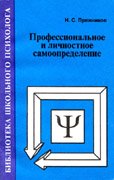 Низкий уровень : отсутствие потребности и способности самому что-то делать для своего развития (что может сочетаться с высокой дисциплиной как исполнителя). Отсутствие внутреннего смысла и стержня существа личности. Отсутствие интереса к самоанализу. Напряженность и комплексы в учебной работе.
Низкий уровень : отсутствие потребности и способности самому что-то делать для своего развития (что может сочетаться с высокой дисциплиной как исполнителя). Отсутствие внутреннего смысла и стержня существа личности. Отсутствие интереса к самоанализу. Напряженность и комплексы в учебной работе.
Самовоспитание осуществляется в процессе самоуправления, которое строится на основе сформулированных человеком целей, программы действий, контроля за выполнением программы, оценки полученных результатов, самокоррекции (Миславский Ю.А., 1991; см. аннотацию). Основные методы самовоспитания отражены в рисунке 7.
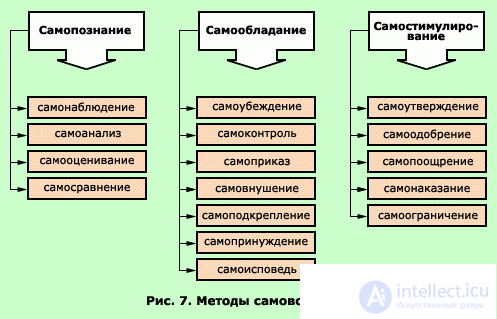
Принципы - общие руководящие положения, требующие последовательности действий при различных условиях и обстоятельствах.
Союз трех принципов воспитания придает гармонически сочетающиеся характеристики: философическую, диалогическую, этическую. Они не могут существовать одна без другой, точно так же, как реализация одного из названных принципов современного воспитания в оторванности от других невозможна (Хрест. 11.3) (http://www.pirao.ru/strukt/lab_gr/g-fak.html).
Педагогические закономерности воспитания - это адекватное отражение объективной действительности воспитательного процесса, обладающего общими устойчивыми свойствами при любых конкретных обстоятельствах.
The situation of success is the subjective experience of achievements, the inner satisfaction of the child with the very participation in the activity, with his own actions and with the result.
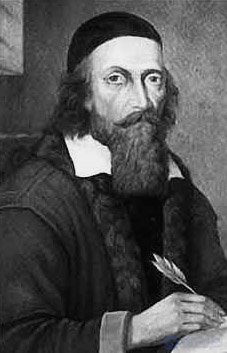 Understanding education as the creation of conditions for human development determines the principles of nature and culture. From the approach to education as to the purposeful development of the personality follows the principle of the centering of education on the development of personality. The connection of education with other factors of human development is reflected in the principle of complementarity.
Understanding education as the creation of conditions for human development determines the principles of nature and culture. From the approach to education as to the purposeful development of the personality follows the principle of the centering of education on the development of personality. The connection of education with other factors of human development is reflected in the principle of complementarity.
Principle nature nature education. The idea originated in antiquity (Democritus, Plato, Aristotle). It was most deeply founded and developed by Ya.A. Komensky (Komensky Ya.A., 1982). The principle of nature conformity occupied a significant place in the pedagogical systems of J.-J. Rousseau, I.G. Pestalozzi, F.A. Disterwega. With different interpretations of the very concept of nature, they were united by the approach to man as a part of it and the statement of the need for his upbringing in accordance with the objective laws of human development in the outside world.
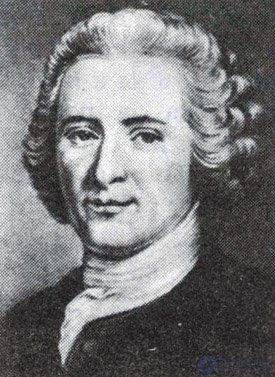 Comenius believed that the order of the school must be borrowed from nature and proceed from observations of natural processes. According to Rousseau, in the upbringing it is necessary to follow the nature of the child, his age characteristics, to create conditions for the natural development of his innate properties and abilities (Rousseau J.J., 1981). Pestalozzi, understanding nature conformability, like Rousseau, stressed that the efforts made by nature to develop human forces, without human help, slowly liberate people from "sensual-animal properties". Disterveg considered it necessary to take into account the process of natural human development at each age stage (Disterweg, FA, 1956).
Comenius believed that the order of the school must be borrowed from nature and proceed from observations of natural processes. According to Rousseau, in the upbringing it is necessary to follow the nature of the child, his age characteristics, to create conditions for the natural development of his innate properties and abilities (Rousseau J.J., 1981). Pestalozzi, understanding nature conformability, like Rousseau, stressed that the efforts made by nature to develop human forces, without human help, slowly liberate people from "sensual-animal properties". Disterveg considered it necessary to take into account the process of natural human development at each age stage (Disterweg, FA, 1956).
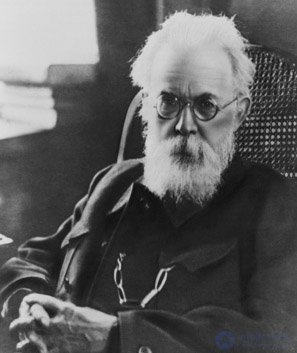 The principle of nature in the European pedagogy of the XVIII-XIX centuries. served as the basis for various theories of education, which received the general name of pedagogical naturalism, including and the theory of free education . The principle of nature conformity was also the basis of pedology , some ideas of which are preserved in the theories of the age approach and the individual approach . The development of the sciences of nature and man in the XX century. significantly enriched the content of the principle of nature education. A special role was played by the doctrine of the noosphere V.I. Vernadsky (Vernadsky VI, 1981).
The principle of nature in the European pedagogy of the XVIII-XIX centuries. served as the basis for various theories of education, which received the general name of pedagogical naturalism, including and the theory of free education . The principle of nature conformity was also the basis of pedology , some ideas of which are preserved in the theories of the age approach and the individual approach . The development of the sciences of nature and man in the XX century. significantly enriched the content of the principle of nature education. A special role was played by the doctrine of the noosphere V.I. Vernadsky (Vernadsky VI, 1981).
The modern interpretation of the principle of nature conformance is based on the fact that education should be based on a scientific understanding of natural and social processes, consistent with the general laws of nature and man’s development, and form responsibility for the evolution of the noosphere and of itself. The content, methods and forms of education should take into account the need for age and sex differentiation of education, the organization of a person’s social experience and individual assistance to him. In humans, it is necessary to cultivate a desire for a healthy lifestyle and the ability to survive in extreme conditions. Of particular importance are the development of planetary thinking and education environmental behavior.
The development of man and his needs must be brought out of the “I” and the nearest society, helping to understand the global problems of humanity, to feel a sense of ownership of nature and society, responsibility for their condition and development.
 The idea first appeared in the works of D. Locke, who spoke out against the theory of "innate" ideas and argued that the soul of a child is tabula rasa ("clean board") (Locke J., 1960). He explained the origin of knowledge from human experience, the differences in which are determined by upbringing and living conditions. K.A. Helvetius, based on the ideas of Locke, argued that a person is formed only under the influence of the environment and education (Helvetius KA, 1974). Locke and Helvetius paid attention to the sociocultural factor in education. Pestalozzi formulated the principles of a folk school that prepares children for life in a specific socio-cultural environment (Pestalozzi IG, 1981).
The idea first appeared in the works of D. Locke, who spoke out against the theory of "innate" ideas and argued that the soul of a child is tabula rasa ("clean board") (Locke J., 1960). He explained the origin of knowledge from human experience, the differences in which are determined by upbringing and living conditions. K.A. Helvetius, based on the ideas of Locke, argued that a person is formed only under the influence of the environment and education (Helvetius KA, 1974). Locke and Helvetius paid attention to the sociocultural factor in education. Pestalozzi formulated the principles of a folk school that prepares children for life in a specific socio-cultural environment (Pestalozzi IG, 1981).
 The principle of cultural conformity in pedagogy formulated Disterweg, who argued that in the upbringing it is necessary to take into account the conditions of the place and time in which a person was born and lives, that is, all modern culture in the broad sense of the word and of a particular country, which is the birthplace of the child. This principle reflected the tendency of formation of national states and national cultures and was widely recognized in the pedagogy of the XIX-XX centuries. Russian teachers also developed this idea. KD Ushinsky, L.N. Tolstoy wrote about the national education. P.F. Kapterev considered the correlation of upbringing, social conditions and culture, which he interpreted as a combination of religion, life and morality of the people (Kapterev PF, 1999; annotation). S.I. Hessen understood the principle of cultural conformity, on the one hand, as the unity of the school with society and the nation as a whole, and on the other, he justified the need to create a specific "regional pedagogy" (he used this designation after the French teacher and J. Oruz).
The principle of cultural conformity in pedagogy formulated Disterweg, who argued that in the upbringing it is necessary to take into account the conditions of the place and time in which a person was born and lives, that is, all modern culture in the broad sense of the word and of a particular country, which is the birthplace of the child. This principle reflected the tendency of formation of national states and national cultures and was widely recognized in the pedagogy of the XIX-XX centuries. Russian teachers also developed this idea. KD Ushinsky, L.N. Tolstoy wrote about the national education. P.F. Kapterev considered the correlation of upbringing, social conditions and culture, which he interpreted as a combination of religion, life and morality of the people (Kapterev PF, 1999; annotation). S.I. Hessen understood the principle of cultural conformity, on the one hand, as the unity of the school with society and the nation as a whole, and on the other, he justified the need to create a specific "regional pedagogy" (he used this designation after the French teacher and J. Oruz).
In the USSR, the principle of cultural conformity was sometimes interpreted as contradicting the attitudes of class and internationalism, declarative statements about the development of the culture of each nation as national in form and socialist in content. 
 At the same time, there was no complete rejection of the principle of cultural conformity in Soviet pedagogy. This principle was developed by S.T. Shatsky (Shatsky S.T., 1980), V.A. Sukhomlinsky (Sukhomlinsky VA, 1979; see annotation) and others.
At the same time, there was no complete rejection of the principle of cultural conformity in Soviet pedagogy. This principle was developed by S.T. Shatsky (Shatsky S.T., 1980), V.A. Sukhomlinsky (Sukhomlinsky VA, 1979; see annotation) and others.
The modern interpretation of the principle of cultural conformity implies that education should be based on universal human values and be based on the characteristics of ethnic and regional cultures, solve the problem of human familiarization with different layers of culture (everyday, physical, sexual, material, spiritual, political, economic, intellectual, moral and others ). The goals, content, methods of education are culturally similar if they take into account the traditions and style of socialization that have historically been established in a particular society.
The principle of the centering of education on the development of the personality is based on the idea that the task of education is the development of man, which was embodied in the works of many thinkers. In the philosophical-pedagogical tradition of the new and modern times, there are 3 approaches to its disclosure. Interpretation of education as a comprehensive and harmonious (and later holistic) development is most characteristic of Zh.Zh. Rousseau, K. Marx and their followers.
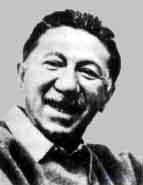 At the beginning of the twentieth century. in line with the philosophy of pragmatism (D. Dewey and others) the idea of development in the process of education was seen as ensuring the growth of a person, satisfying his interests and needs (Dewey J., 1999; see annotation). In the second half of the twentieth century. Humanistic psychology (K. Rogers, A. Maslow, G. Allport, and others) has gained great popularity, in which human development is interpreted as a process of free realization of his potential, and upbringing as the creation of opportunities for self-realization and self-actualization. The principle is based on the recognition of the priority of the individual in relation to society, the state, social institutions, groups and collectives and assumes that this position should be the basis of the philosophy of education, the ideology of society in the field of education, the central value orientation of both educators and students. Limiting the priority of a person is possible only if it is necessary to ensure the rights of other individuals. The process of education, institutions of education and community of pupils with this approach are considered only as a means of personal development.
At the beginning of the twentieth century. in line with the philosophy of pragmatism (D. Dewey and others) the idea of development in the process of education was seen as ensuring the growth of a person, satisfying his interests and needs (Dewey J., 1999; see annotation). In the second half of the twentieth century. Humanistic psychology (K. Rogers, A. Maslow, G. Allport, and others) has gained great popularity, in which human development is interpreted as a process of free realization of his potential, and upbringing as the creation of opportunities for self-realization and self-actualization. The principle is based on the recognition of the priority of the individual in relation to society, the state, social institutions, groups and collectives and assumes that this position should be the basis of the philosophy of education, the ideology of society in the field of education, the central value orientation of both educators and students. Limiting the priority of a person is possible only if it is necessary to ensure the rights of other individuals. The process of education, institutions of education and community of pupils with this approach are considered only as a means of personal development.
In Europe, America, Japan, there are many different theories and approaches to education. The first group consists of concepts in which upbringing is viewed as more or less rigid guidance of students, the formation of personality traits set by society. This can be called authoritarian, technocratic pedagogy. The educational concepts of the second group can be given a generic name - the humanistic school. In general, the educational systems of the West base their theories on the philosophy of pragmatism, positivism, existentialism. Psychoanalysis and behaviorism are the psychological basis of most educational concepts of the West
(http://www.voppsy.ru/journals_all/issues/1995/952/952019.htm; see Vorobyeva VN’s article “Humanitarian psychology: subject and tasks”).
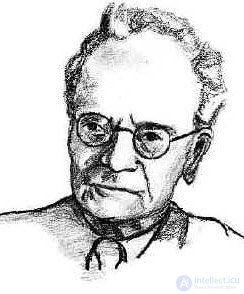 Developers of a technocratic authoritarian pedagogy proceed from the fact that the task of the educational system of the school and society is the formation of a “functional” executing person adapted to life in this social system, prepared to fulfill the corresponding social roles. So, in the USA, these roles are: citizen, worker, family man, consumer. Education should be built on a rational scientific basis, programming the behavior of people and controlling its formation. The creator of technocratic pedagogy is B. Skinner. Soviet pedagogy tried to build education precisely as a controlled and controlled process, seeking to determine the exact goals, objectives, content, methods and forms of work. Representatives of the technocratic approach in the West also stand on the position that the process of the formation and upbringing of the individual must be strictly directed and lead to projected results. However, in this approach lies the threat of manipulation of the individual, the danger of getting a human functionary, a thoughtless performer. Education is understood as behavior modification, as the development of "correct" behavioral skills. The basis of technocratic pedagogy is the principle of modifying the behavior of students in the right direction.
Developers of a technocratic authoritarian pedagogy proceed from the fact that the task of the educational system of the school and society is the formation of a “functional” executing person adapted to life in this social system, prepared to fulfill the corresponding social roles. So, in the USA, these roles are: citizen, worker, family man, consumer. Education should be built on a rational scientific basis, programming the behavior of people and controlling its formation. The creator of technocratic pedagogy is B. Skinner. Soviet pedagogy tried to build education precisely as a controlled and controlled process, seeking to determine the exact goals, objectives, content, methods and forms of work. Representatives of the technocratic approach in the West also stand on the position that the process of the formation and upbringing of the individual must be strictly directed and lead to projected results. However, in this approach lies the threat of manipulation of the individual, the danger of getting a human functionary, a thoughtless performer. Education is understood as behavior modification, as the development of "correct" behavioral skills. The basis of technocratic pedagogy is the principle of modifying the behavior of students in the right direction.
The formation of behavioral skills is necessary, but one cannot neglect the personal will of the personality, its consciousness, freedom of choice, goals and values, which determines the actual human behavior.
The modification method involves the development of the desired behavior in various social situations with the help of "backers": approval or censure in various forms. There is nothing bad in the modification method, if we mean the effect on the consciousness, behavior, and emotions of a person with the aim of his development. But if the modification of behavior leads to manipulation of personality, neglects its interests, serves as external adaptation, without appealing to one's own will and freedom, then this is inhumane. The extreme expression of the technocratic approach is the theory and practice of psychotropic effects on students and adults. Educating with the help of pharmacological drugs is contrary to all moral and legal norms.
The model of education of humanistic pedagogy, which is based on the direction of humanistic psychology, developed in the 50-60s. Twentieth century. in the USA in the works of such scientists as A. Maslow, V. Frankl, K. Rogers, J. Kelly, and others.
 The main concepts of humanistic pedagogy are “self-actualization of a person”, “personal growth”, “developmental assistance”. Each person is a complete education, a unique personality. Personality behavior is not determined by reinforcements coming from the external environment, as behaviourism teaches, but by the innate desire of a person for actualization — the development of his natural abilities, the search for his own meaning and life path. Personality is understood as a complex autonomous system, distinguished by orientation, the will to positive activity and cooperation. Self-actualization is the realization of oneself in activities, in relations with people, in a full-blooded "good" life on a chosen and changing life path. This condition is indicated in K. Rogers by the concept of "fully functioning person." In psychotherapy and pedagogy of Rogers, the psychotherapist and teacher should arouse a person’s own strengths to solve his problems. Not to impose a ready-made solution on him, but to stimulate his own work on personal change and growth, which never have limits. The purpose of training and education should not be the acquisition of knowledge as a collection of knowledge, facts, theories, etc., but a change in the personality of the student as a result of independent learning. The task of the school and upbringing is to give an opportunity for the development, self-development of the individual, to contribute to the search for their individuality, to help a person go towards self-actualization.
The main concepts of humanistic pedagogy are “self-actualization of a person”, “personal growth”, “developmental assistance”. Each person is a complete education, a unique personality. Personality behavior is not determined by reinforcements coming from the external environment, as behaviourism teaches, but by the innate desire of a person for actualization — the development of his natural abilities, the search for his own meaning and life path. Personality is understood as a complex autonomous system, distinguished by orientation, the will to positive activity and cooperation. Self-actualization is the realization of oneself in activities, in relations with people, in a full-blooded "good" life on a chosen and changing life path. This condition is indicated in K. Rogers by the concept of "fully functioning person." In psychotherapy and pedagogy of Rogers, the psychotherapist and teacher should arouse a person’s own strengths to solve his problems. Not to impose a ready-made solution on him, but to stimulate his own work on personal change and growth, which never have limits. The purpose of training and education should not be the acquisition of knowledge as a collection of knowledge, facts, theories, etc., but a change in the personality of the student as a result of independent learning. The task of the school and upbringing is to give an opportunity for the development, self-development of the individual, to contribute to the search for their individuality, to help a person go towards self-actualization.
The doctrine in which the student is interested, where there is not just an accumulation of facts, but a change in the student, his behavior, his I-concept (Fig. 10), C. Rogers called "a meaningful teaching for a person" and believed that it was the only way be.
Waldorf pedagogy is a set of methods and techniques of education and training, based on the anthroposophical interpretation of human development as a holistic interaction of bodily, mental and spiritual factors (Russian ..., 1993-1996, V. 2).
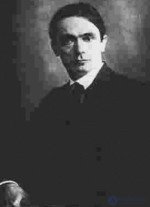 Methodological and didactic-methodical foundations of Waldorf pedagogy developed by R. Steiner. It is used in the so-called free Waldorf schools (the first was opened in Stuttgart in 1919 for children of the workers of the Waldorf-Astoria factory; hence the name), in the Waldorf kindergartens and in the Kemphill medical-pedagogical institutions. In 1933-1945 in the territory of the fascist Reich, Waldorf educational institutions were closed, teachers were repressed. The movement to open Waldorf schools resumed after World War II, especially after the 60s. The twentieth century, covering many countries. By 1990, there were about 500 Waldorf schools, about 1,000 kindergartens in the world. These are private institutions, sometimes with partial state subsidies (in different countries - from 30 to 80%). Waldorf schools provide a full secondary education (12 years of study; for those entering universities there is the 13th, so-called graduate, class).
Methodological and didactic-methodical foundations of Waldorf pedagogy developed by R. Steiner. It is used in the so-called free Waldorf schools (the first was opened in Stuttgart in 1919 for children of the workers of the Waldorf-Astoria factory; hence the name), in the Waldorf kindergartens and in the Kemphill medical-pedagogical institutions. In 1933-1945 in the territory of the fascist Reich, Waldorf educational institutions were closed, teachers were repressed. The movement to open Waldorf schools resumed after World War II, especially after the 60s. The twentieth century, covering many countries. By 1990, there were about 500 Waldorf schools, about 1,000 kindergartens in the world. These are private institutions, sometimes with partial state subsidies (in different countries - from 30 to 80%). Waldorf schools provide a full secondary education (12 years of study; for those entering universities there is the 13th, so-called graduate, class).
The task of Waldorf pedagogy is defined as the education of a spiritually free person, capable in individual creativity to overcome the tendency of society to conservatively reproduce existing social structures and patterns of behavior and thus act to the benefit of progress. Supporters of Waldorf pedagogy see it as not a systematic and normative scientific discipline, but “the art of awakening” the natural makings hidden in people. The basis of this art is the multilateral development of Steiner aesthetic ideas I.V. Goethe and F. Schiller, who in his epistemology he expanded to the scope of the transcendent, but interpreted in the categories of being and development. The laws of creativity are considered as arising from the laws of nature and expressing themselves in the spiritual experience of man; creative imagination is promoted to a number of basic principles of pedagogical activity and is associated with “courage to the truth” and a sense of spiritual responsibility.
The main character in Waldorf pedagogy is the class teacher. His responsibilities include the organization of almost the entire educational work with his students during the first 8 years of study (the class capacity is about 30 people). The class teacher develops and teaches basic general education subjects; creates and maintains in the interests of education close interaction between teachers and students, between school and parents. Учитель не работает по жесткому графику: необходимый план должен быть "прочитан" непосредственно в каждом ученике.
Дидактико-методические подходы Штейнер разработал, исходя из представлений Гете о метаморфозе. Развитие человека рассматривается как цепь имманентных ступенчатых преобразований, протекающих в значительной мере под влиянием биогенетического закона. Его действие преодолевается на ступени всестороннего развития, и человек достигает подлинной духовной свободы; создание полноценных предпосылок для такой свободы - главная цель вальдорфской педагогики.
Циклы метаморфоз, по Штейнеру, делят развитие человека на семилетия, хронологически не совпадающие для различных сфер: телесности, мышления, чувств и воли. Перед педагогом ставится задача точно прослеживать эти метаморфозы, создавать благоприятные условия для их протекания. Вальдорфская педагогика исключает прямые воздействия на волю; считается, что воля развивается здоровым образом только в результате правомерных косвенных воздействий. Общий принцип их осуществления - "сначала художественное, затем из него интеллектуальное". Поэтому в вальдорфских учреждениях большое внимание уделяется художественному воспитанию, которое ориентируется на развитие именно живого мышления и прочной воли, но не на подготовку к профессионально художественной деятельности. Искусство рассматривается как наилучшее средство формирования черт личности, способной находить адекватное отношение к меняющимся условиям окружающего мира.
Как правило, обучение делится на 3 ступени: до 9 лет, до 12 лет, до выпуска. Начальное обучение ведется медленно, с преимущественным использованием различных образных форм, которые применяются и на старших ступенях. Предметы учащиеся проходят так называемыми эпохами: в течение 3-4 недель ежедневно на первых уроках дается один и тот же предмет, во время паузы в его преподавании подобным образом изучается другой предмет. Учебники как таковые не применяются. Необходимые записи ученики делают в самостоятельно
продолжение следует...
Часть 1 11. PSYCHOLOGICAL BASES OF METHODS OF EDUCATION
Часть 2 Glossary - 11. PSYCHOLOGICAL BASES OF METHODS OF EDUCATION
Comments
To leave a comment
Pedagogical psychology
Terms: Pedagogical psychology